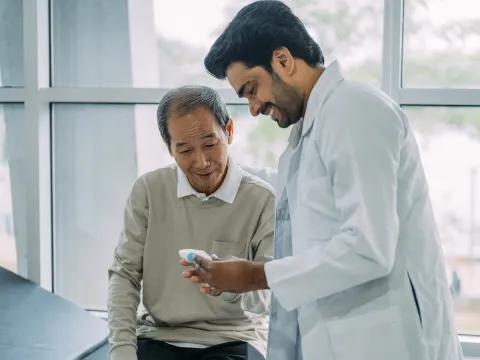- AdventHealth

Choose the health content that’s right for you, and get it delivered right in your inbox.
After a hip replacement surgery, staying physically active is pivotal to your recovery. Safe exercises at home can make it an easier process for you to regain and retain your range of motion after this common surgery.
While you may not be able to engage in all the activities you did before your hip replacement, there are many ways to exercise safely as soon as your doctor gives you the go-ahead. We’re here with some exercise tips to help get you moving again.
Start Out Smart
Most patients start lightly, but doing too much too fast can lead to an injury. Be mindful of your body and never exercise to the point of pain. Wear cushioned shoes that support your arches when walking or engaging in these low-impact exercises to absorb the shock and take the pressure off your hip.
Aerobic Exercise
Aerobic exercise gets your heart rate up and helps you stay fit by burning calories and engaging your muscles. After a hip replacement, try introducing low-impact aerobic activities as you’re able, such as:
- Bicycling
- Swimming
- Walking
Exercises like these will provide a good workout without putting too much stress on your joints or pressure on your hip. It’s best to avoid high-impact aerobics, running and sports that require jumping.
Strengthening Exercises
Strengthening exercises help build muscle tissue to help you stay fit. Exercises that strengthen your hips, thighs and core muscles are particularly valuable following hip replacement surgery.
Using resistance bands while moving your leg to the side, forward and back helps strengthen your hip flexors. Working out with weights, machines, bands or doing other strengthening exercises for your body’s other muscles increases muscle mass, which burns calories to help you stay fit.
Gently doing these exercises as you feel comfortable will help strengthen your hip muscles and increase your flexibility:
- Lunges: good for the legs and glutes
- Squats: increases flexibility in your lower back and hips
- Planks: targets your abdominal muscles and whole body
Stretching Exercises
Gentle stretching improves your flexibility and range of motion. While stretching all of your body's major muscle groups is important, it’s especially important to pay attention to your hip muscles after a hip replacement.
Stretching after your warm-up and cool-down when engaging in aerobic exercise prevents your muscles from tightening after exercise, which can lead to hip pain.
Gentle, slow-paced exercises can help stretch your body along with providing relaxation. Try tai chi or yoga poses, taking care to do them safely.
When You Need Us, We’re Here to Help
At AdventHealth Sports Med and Rehab, we can help you get back on your feet after an illness, injury or surgery with a personalized care plan tailored to your needs. Learn more about our sports medicine and rehabilitation care near you.



